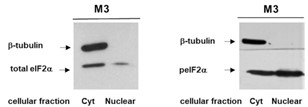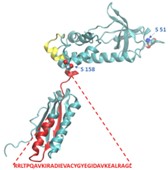EIF2S1
-
Official Full Name
eukaryotic translation initiation factor 2, subunit 1 alpha, 35kDa -
Overview
Eukaryotic translation initiation factor 2 subunit 1?is a?protein?that in humans is encoded by the?EIF2S1?gene. Functions in the early steps of protein synthesis by forming a ternary complex with GTP and initiator tRNA. This complex binds to a 40S ribosomal subunit, followed by mRNA binding to form a 43S preinitiation complex. Junction of the 60S ribosomal subunit to form the 80S initiation complex is preceded by hydrolysis of the GTP bound to eIF-2 and release of an eIF-2-GDP binary complex. In order for eIF-2 to recycle and catalyze another round of initiation, the GDP bound to eIF-2 must exchange with GTP by way of a reaction catalyzed by eIF-2B. -
Synonyms
EIF2S1;eukaryotic translation initiation factor 2, subunit 1 alpha, 35kDa;EIF2;EIF-2;EIF2A;EIF-2A;EIF-2alpha;eukaryotic translation initiation factor 2 subunit 1;eIF-2-alpha;OTTHUMP00000028404;OTTHUMP00000218025;eukaryotic translation initiation factor 2 subunit alpha
Recombinant Proteins
- Human
- Rhesus macaque
- Chicken
- Rat
- Mouse
- E. coli
- Mammalian Cells
- E.coli
- Wheat Germ
- HEK293
- In Vitro Cell Free System
- GST
- His
- DDK
- Myc
- Non
- Avi
- Fc
- Flag
Background

Fig1. Role of eIF2α phosphorylation in the transition between homeostatic and lethal stress responses. (Oliver Kepp, 2015)
What is EIF2S1 protein?
EIF2S1 (eukaryotic translation initiation factor 2 subunit alpha) gene is a protein coding gene which situated on the long arm of chromosome 14 at locus 14q23. The translation initiation factor EIF2 catalyzes the first regulated step of protein synthesis initiation, promoting the binding of the initiator tRNA to 40S ribosomal subunits. Binding occurs as a ternary complex of methionyl-tRNA, EIF2, and GTP. EIF2 is composed of 3 nonidentical subunits, the 36-kD EIF2-alpha subunit (EIF2S1), the 38-kD EIF2-beta subunit (EIF2S2; MIM 603908), and the 52-kD EIF2-gamma subunit (EIF2S3; MIM 300161). The rate of formation of the ternary complex is modulated by the phosphorylation state of EIF2-alpha The EIF2S1 protein is consisted of 315 amino acids and its molecular mass is approximately 36.1 kDa.
What is the function of EIF2S1 protein?
EIF2S1 is involved in the formation of a ternary complex with GTP and initiator methionyl-tRNA (Met-tRNAi), which is essential for the binding to the 40S ribosomal subunit. The phosphorylation state of EIF2S1 modulates the rate of ternary complex formation, thereby acting as a key regulatory point in the initiation of protein synthesis. EIF2S1 is a central component of the ISR, which is activated in response to various cellular stresses. Phosphorylation of EIF2S1 by stress-activated kinases leads to a general inhibition of protein synthesis while promoting the translation of specific stress response genes. Unlike the eIF2 complex, EIF2A (another name for EIF2S1 in the literature) binds Met-tRNAi to the 40S ribosomal subunit in a codon-dependent manner, which is distinct from the GTP-dependent binding of the eIF2 complex. EIF2S1 phosphorylation inhibits global protein synthesis under stress conditions, allowing the cell to adapt and maintain homeostasis.
EIF2S1 Related Signaling Pathway
EIF2S1 is a component of the eIF2 complex, which is essential for the first step of protein synthesis initiation by facilitating the binding of initiator tRNA to the 40S ribosomal subunit. Under hypoxic conditions, EIF2S1 can be involved in the regulation of protein synthesis and the adaptation to low oxygen levels, which is a common feature of the tumor microenvironment and can influence cancer progression and metastasis. EIF2S1 is involved in the UPR, a cellular response to the accumulation of unfolded or misfolded proteins in the ER. Activation of the PERK branch of the UPR leads to the phosphorylation of EIF2S1, which in turn modulates protein synthesis to alleviate ER stress.
EIF2S1 Related Diseases
The variation or functional abnormality of EIF2S1 gene is associated with a variety of diseases, mainly including EIF2B-related disorders associated with leukoencephalopathy, such as vanishing white matter disease and ovarian failure; Wolcott-Rallison Syndrome, a rare inherited metabolic bone disease; Fatty liver disease, in which EIF2S1 plays a role in regulating lipogenesis; Some viral infections, such as influenza, play a role in the host's response to the virus; Neurodegenerative diseases, possibly due to their role in the regulation of protein synthesis; Cancers, including pancreatic cancer and melanoma, in which EIF2S1 expression levels may be associated with disease development and prognosis; Amyotrophic lateral sclerosis (ALS), which may play a role in motor neuron degeneration; And Alzheimer's disease, may be involved in its pathogenesis by affecting the regulation of protein synthesis.
Bioapplications of EIF2S1
EIF2S1, as a subunit of eukaryotic translation initiation factor 2, has broad application prospects, especially in the following aspects: First, because of its central role in the regulation of protein synthesis, EIF2S1 is an important tool for studying cellular stress response and protein homeostasis; Second, changes in activity or expression levels of EIF2S1 are associated with a variety of diseases, and therefore, it can be used as a biomarker for disease diagnosis, especially in the early detection of liver disease, certain cancers, and neurodegenerative diseases; In addition, drug development targeting EIF2S1 or its regulatory pathways may provide new strategies for the treatment of related diseases, such as interfering with cell response to stress by modulating the phosphorylation of EIF2S1, it can develop EIF2S1 antibody researches; Finally, EIF2S1 is also an important molecular target in basic research to explore cell signaling, protein synthesis mechanisms, and cell cycle regulation.
Case Study
Case Study 1: Immacolata Maida, 2019
Melanoma cells develop adaptive responses in order to cope with particular conditions of tumor microenvironment, characterized by stress conditions and deregulated proliferation. Recently, the interplay between the stress response and the gene expression programs leading to metastatic spread has been reported. Researchers evaluated levels and localization of eIF2α/peIF2α in V600BRAF and wtBRAF metastatic melanoma cell lines by means of western blot and confocal microscopy analyses. Furthermore, they performed a sequence analyses and structure and dynamics studies of eIF2α protein to reveal the role of eIF2α and its correlations in different pathways involved in the invasive phase of melanoma. This studies on eIF2α protein sequence indicated the presence of a predicted bipartite NLS as well as a nuclear export signal NES and an S1 domain, typical of RNA interacting proteins. In conclusion, this is the first evidence of nuclear localization of peIF2α, representing a possible target for future therapeutic approaches for metastatic melanoma.

Fig1. Western blotting analyses using eIF2α (total form) or peIF2α (S51) antibodies were performed on M3 nuclear and cytoplasmic fractions.

Fig2. Structure of the α subunit of the eIF2α.
Case Study 2: Paulina Podszywalow-Bartnicka, 2016
Recent studies underscore the role of the microenvironment in therapy resistance of chronic myeloid leukemia (CML) cells and leukemia progression. Researchers previously showed that sustained mild activation of endoplasmic reticulum (ER) stress in CML cells supports their survival and resistance to chemotherapy. Using dominant negative non-phosphorylable mutant of eukaryotic initiation factor 2 α subunit (eIF2α), that phosphorylation of eIF2α (eIF2α-P), which is a hallmark of ER stress in CML cells, researchers substantially enhances their invasive potential and modifies their ability to secrete extracellular components, including the matrix-modifying enzymes cathepsins and matrix metalloproteinases. These changes are dependent on the induction of activating transcription factor-4 (ATF4) and facilitate extracellular matrix degradation by CML cells. Conditioned media from CML cells with constitutive activation of the eIF2α-P/ATF4 pathway induces invasiveness of bone marrow stromal fibroblasts, suggesting that eIF2α-P may be important for extracellular matrix remodeling and thus leukemia cells-stroma interactions.

Fig3. eIF2α-P level in FACS-sorted K562 cells.

Fig4. Gelatinase activity of S-media from K562wt and K562mut cells was analyzed by zymography.
Quality Guarantee
High Purity
.jpg)
Fig1. SDS-PAGE (EIF2S1-3172H)
.
.jpg)
Fig2. SDS-PAGE (EIF2S1-3542H)
Involved Pathway
EIF2S1 involved in several pathways and played different roles in them. We selected most pathways EIF2S1 participated on our site, such as ABC-family proteins mediated transport,Activation of the mRNA upon binding of the cap-binding complex and eIFs, and subsequent binding to 43S,BDNF signaling pathway, which may be useful for your reference. Also, other proteins which involved in the same pathway with EIF2S1 were listed below. Creative BioMart supplied nearly all the proteins listed, you can search them on our site.
| Pathway Name | Pathway Related Protein |
|---|---|
| BDNF signaling pathway | YBX1,FRS2,SIRPA,CDKL5,LINGO1,DOK5,CDH2,GNB2L1,BCL2L11,EGR1 |
| Eukaryotic Translation Initiation | FAUB,EIF5,EIF4EB,RPL35,EIF4B,EIF4A1,EIF1AX,EIF3K,EIF4A2,EIF2B1 |
| GTP hydrolysis and joining of the 60S ribosomal subunit | EIF1AXA,EIF2S3,EIF3K,EIF1AX,EIF4A1,EIF4H,EIF2S1A,EIF5,RPL35,EIF4A2 |
| ABC-family proteins mediated transport | EIF2S3,ABCA7,ABCG4B,ABCF1,ABCB8,ABCE1,KCNJ11,ABCA8,EIF2S1A,ABCD3B |
| Gene Expression | ZNF274,EEF2,ZNF680,ZNF473,TSEN15,MED10,EFCAB11,BRF1B,ZNF143,BCAS2 |
| Activation of the mRNA upon binding of the cap-binding complex and eIFs, and subsequent binding to 43S | EIF2S3,EIF4B,EIF3K,EIF4E,EIF4EB,EIF2S1A,FAUB,EIF4A2,EIF4G1,EIF1AX |
| Cap-dependent Translation Initiation | RPL35,EIF2S1A,EIF4A1,EIF3K,EIF4H,EIF4A2,EIF4EB,EIF1AX,EIF2S3,EIF4G1 |
| Formation of the ternary complex, and subsequently, the 43S complex | EIF2S3,EIF2S1A,EIF1AX,FAUB,EIF3K,EIF1AXA |
Protein Function
EIF2S1 has several biochemical functions, for example, poly(A) RNA binding,protein binding,ribosome binding. Some of the functions are cooperated with other proteins, some of the functions could acted by EIF2S1 itself. We selected most functions EIF2S1 had, and list some proteins which have the same functions with EIF2S1. You can find most of the proteins on our site.
| Function | Related Protein |
|---|---|
| poly(A) RNA binding | POP7,VCP,FAM98B,CLNS1A,RBM47,VSIG8,HIST1H4I,MRM1,HNRNPH1,RPL27 |
| ribosome binding | ICT1,EIF2A,EIF6,RPSA,ABCF1,CPEB1A,EFTUD1,MTOR,C12orf65,EIF5A2 |
| translation initiation factor activity | EIF1B,EIF1AD,EIF1AY,MTIF2,EIF4H,EIF4G1,EIF3B,EIF3HB,EIF3S6IP,EIF4G3 |
| protein binding | CX3CR1,TBX5,RAVER2,GRK5,GLRB,RPA3,CYFIP1,RAB21,SMN1,COL1A1 |
Interacting Protein
EIF2S1 has direct interactions with proteins and molecules. Those interactions were detected by several methods such as yeast two hybrid, co-IP, pull-down and so on. We selected proteins and molecules interacted with EIF2S1 here. Most of them are supplied by our site. Hope this information will be useful for your research of EIF2S1.
EIF2AK2;Eif2ak3;DDX3X;EIF2S2;EIF4G2;Dlg4
Resources
Related Services
Related Products
References
- Vlahakis, A; Powers, T; et al. A role for TOR complex 2 signaling in promoting autophagy. AUTOPHAGY 10:2085-2086(2014).
- Zhang, XN; Yuan, Y; et al. Endoplasmic reticulum stress induced by tunicamycin and thapsigargin protects against transient ischemic brain injury Involvement of PARK2-dependent mitophagy. AUTOPHAGY 10:1801-1813(2014).


